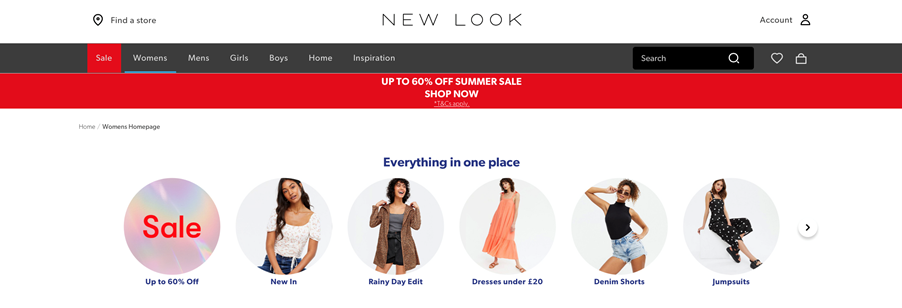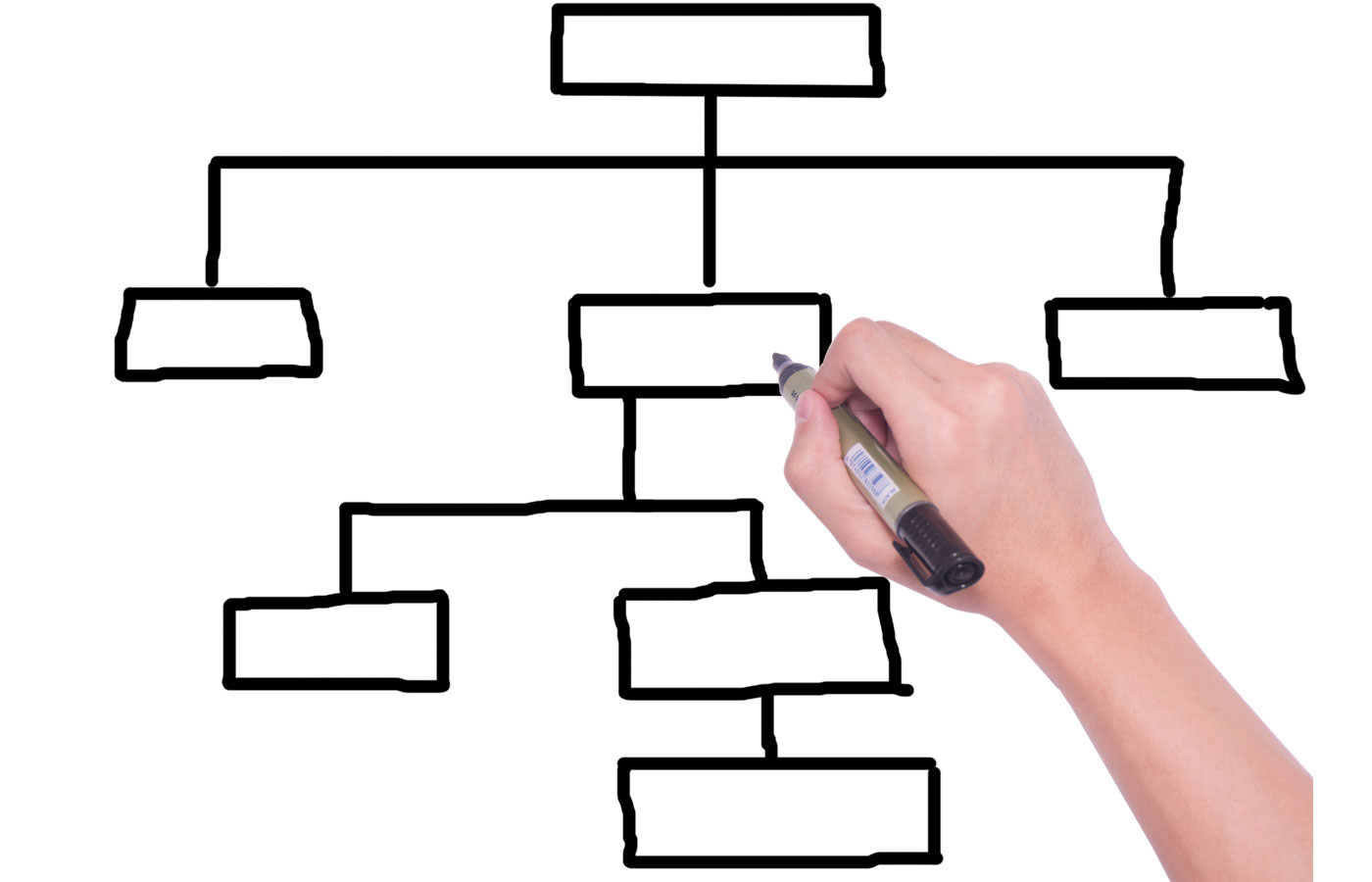
Whether it is for your blog, service page or e-commerce store, category pages are essential for boosting your site’s SEO and user experience. A site with clear, user-friendly categories is more likely to rank high in searches and lead to conversions – a win-win for your business.
We’ve made it easy for you – keep reading for our complete guide to mastering your copy for your site’s category page SEO. But before we dive in – what exactly is a category page?
What is a category page?
A page where similar products, services or blog posts are listed, category pages should help your visitors find what they need. According to Big Commerce, categories group individual web pages together based on a similar subject or theme.
For example, a clothing retailer will use category page SEO to help categorise all of the different types of clothing that they sell for men, women or children.
Here is an example for UK clothing retailer, New Look. New Look uses categories: Sale, Women’s, Men’s, Girls, Boys, and Inspiration to organise its site, with each category containing subcategories for further, user-friendly searching. Pictured is the category page Women’s Clothing.

Categories organise your content in a way that should make it easy for the user to find what they are looking for, whether they have a product in mind or are just searching for some inspiration. Your site’s category pages will serve as a landing page for all the pages and posts that belong to that particular subject, making this process a lot easier.
If you take a look at New Look’s category page for women’s clothing, you will be greeted by:
- links to subcategories listed by product types
- blog posts on women’s style
- the option to shop by body type or fit
- promotions that will hopefully influence a customer’s buying decision
This category page – in fact, all category pages – should help site visitors find the best solution or product for them.
When to use a category page?
When adding a product, blog post or service to your website, you should always assign it to a category. Sometimes, you will be adding it to multiple categories. This is a common practice across clothing websites when there is a sale or promotion active – that cheap pair of jeans can now be found in the Sale and Jeans categories of the retailer’s website.
But avoid overlapping your categories too much and keep user intent in mind when organising and tagging your content. If the target customer struggles to find what they are looking for, you may lose out on that customer.
But we often get asked, how many pieces of content make for an effective category page SEO strategy?
And the answer is: some. For category page SEO to be relevant and carry enough SEO weight, they can’t be thin or empty. You’ve also got to think about UX first – you don’t want potential customers bouncing back to the search engine results page. It’s all about first impressions. If your chosen category has only one or two products or posts, perhaps think about how you can rename or reorganise your site.
Using subcategories
If you have lots of content that needs organising on your site, then using subcategories will be your best friend. Subcategories boost UX by giving customers the ability to filter through your products, services or posts, finding something that perfectly meets their needs. They’re also good for category description SEO. With sub-categories, you can now target multiple search terms instead of just one or two.

New Look uses subcategories to help customers shop by fit, product type and trend. Where your category pages give customers a lift to the start of the race, your subcategory pages narrow their options, leaving the search results more manageable and the view to the add-to-cart finishing line a lot clearer.
But why are SEO category pages important?
Besides the website’s homepage, the category and subcategory pages on your site can account for most of your website’s traffic. Did you know that on average, 39% of all web traffic comes from search engines? With this in mind, why wouldn’t optimised category pages be one of the most critical assets of your site?
And Yoast agrees:
“Your category archives are more important than individual pages and posts. If your site is a blog and you write several articles about a topic, your category for that topic should be #1 in the search result.”
Clear organisation of categories and category pages make a massive difference. Without this, Google will struggle to tell what your blog is about. However, it isn’t just about ranking high in searches: user experience is just as important – and here’s why.
Why are category pages good for UX?
Clear categories and category pages will result in a higher conversion rate. When a customer reaches your website, they will expect a quick and easy buying experience. Having optimised category and subcategory pages will make life easier for you, Google and your customer.
Category pages can also be used to elevate your marketing game as you respond to viral trends and the latest fashion statements. During lockdown, many of the UK’s biggest fashion retailers added categories labelled ‘Work from Home’, offering their comfiest loungewear all in one place.
Your site structure matters
Yes, you heard that right. Category pages act as signposts, directing Google and its users to specific locations. It is vital that your category pages are optimised, with titles and descriptions written with SEO in mind, so you can hand this information to Google on a silver platter.
And Yoast has a good point on this: “Structuring your website is crucial for both usability and findability. A lot of sites lack a decent structure to guide visitors to the product they’re looking for. Apart from that, having a clear site structure leads to a better understanding of your site by Google, so it’s very important for your SEO.”
This means it is absolutely critical for Google to understand the different sections of your site and what they are about.
How can you master the perfect site structure? Here are a few thoughts to keep in mind:
- Google sees the top of the fold content as a higher priority and more important, therefore include your category descriptions at the top of the page.
- Consider using ‘Read more’ expansion buttons and only show a snippet of the description text. That way, search engines can read the text for SEO purposes, and the user isn’t put off by a massive wall of text.
- Think about the appearance of your category description. It doesn’t just have to be a plain wall of black text – feel free to get creative.
- Don’t overlook internal links. Linking to sub-categories from main categories, between categories and to important products is great category page SEO.

So, now you the know basics, you’re ready to get started with the research
Firstly, how many categories should I have?
We recommend organising your products for the key categories that are essential for your site. You should then use your keyword research to find out what customers are searching for and create categories on your site to target those searches. How many categories you create will all depend on the number of products you have and the many ways that they can be broken down into search categories.
Picking the right keywords.
Since the first primitive SEO cave paintings were made, SEO copywriters have used keywords to move their client’s websites up the rankings. This remains the same when writing descriptions for your category pages. Despite the many changes and algorithm updates carried out by search giants like Google and Bing, keywords have remained a vital ingredient of the SEO pie.
So how do you pick the right keywords?
Like any copy written with SEO in mind, you’ll want to avoid oversubscribed keywords. Use a keyword research tool to determine what users would search for to find your website category. Target high volume, low competition keywords for the biggest success and remember to include associated and long-tail keywords, too.
You can use online tools and resources to help generate your keywords. Here are a few of our favourites: Ahrefs, SEMrush, and Answer The Public.
And a few things to remember:
- Track the keyword rankings of category pages using a keyword tracking tool or your own report.
- Conduct yearly reviews of category pages. Are they still relevant and targeting the best keywords? If not, it’s time to optimise again.
- And finally, ensure that your category descriptions aren’t targeting the same keywords as other pages or include duplicate content.

Checking your competition
If there’s a chance your competitors are taking hold of an opportunity that you are not, don’t be afraid to take a look and check out their category activity. This is a critical, not-to-miss step to help find categories you are yet to cover.
And how can you do this, I hear you ask? Here are a few brilliant tips from Brain Labs Digital:
- Head to their website and take a look at their navigation menu. This will give you a good idea of their site structure and keyword coverage used in their category titles. Next, take a look at the category pages themselves, again looking at the descriptions for keywords that stand out.
- Use tools like Ahrefs or SEMrush to audit your competitors, looking at the keywords they use and where they rank.
- Take a deeper dive into your competitor’s site and gather information and keywords from their metadata, including page titles, meta descriptions and headings. Their most important keywords will be stored there, so it is a great place to investigate new opportunities.
Armed with your very best keywords, now it is time to write your category descriptions.
Here are our top tips to help you master your category descriptions for SEO and UX:
- Write short but unique descriptions which can be expanded/collapsed by the user (especially convenient on mobile where space is precious). Aim for around 160-200 characters. Lower than this, and you can’t fit as many keywords into the text. Higher than this risks pushing your content too far beneath the fold.
- Your description needs to be a valuable addition to the metadata of your site. This way, we are helping Google understand what the page is about – especially for new pages that the search engine is crawling for the first time.
- Use your category description as a selling tool. Recommend products, trends, posts and services. Your description isn’t just for SEO – keep the customer in mind at all times and be informative. This brings me to my next and final point.
- Don’t forget your internal linking opportunities. Include direct links to the other pages and products on your site – even link your top three blog posts. A good internal linking structure is excellent for SEO, and other pages will see the benefit.

Conclusion
So now you know the ins and outs of the category page SEO. Although often overlooked, we cannot stress the importance of optimising these pages enough. Category pages are the foundation of e-commerce and blog sites, so we SEOs must keep a close eye. By following our advice, it will become easier to identify opportunities to capitalise on your site’s search engine traffic.
Still feel like you need a helping hand?
Over the last fifteen years, we’ve written millions of words of SEO copy, helping brands achieve higher rankings on search engines. Our focus is on quality and authenticity, with a team of writers that produce credible, intelligent content quickly and affordably.
If you want your content to cut through the online noise, it shouldn’t just talk. It needs to sing! Get in touch today.
